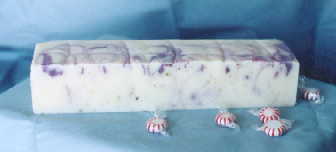 |
PEPPERMINT SWIRL
 -a very soothing and relaxing fragrance with a twist.
The most common use of peppermint is for digestive problems. The
dried leaves are often made into a tea sipped for indigestion, cramps,
or gas.
The essential oil has been shown to be effective at relieving spasms of
smooth muscle through calcium-channel blocking activity. This could
make peppermint oil useful in relieving spasms of the colon.
Enteric-coated peppermint oil is used in the short-term treatment of
irritable bowel syndrome, although not all double-blind studies have
shown statistically significant benefits.
Gastroenterologists in England sprayed dilute peppermint oil directly on
the instrument used for colonoscopy to prevent spasm. This innovative
use of peppermint oil has not been widely adopted.
Peppermint oil and leaf flavonoids both increase the production of bile.
This lends credence to the herb's traditional use as an aid to digestion.
In addition, menthol lowers the activity of a liver enzyme (HMG CoA
reductase) and might in theory lower cholesterol. This possible
therapeutic use is hypothetical and has not been clinically tested.
Likewise, peppermint oil has antibacterial and antiviral properties in the
test tube, but it is not used to treat infections. Peppermint tea is,
however, sometimes used to alleviate the discomfort of gastroenteritis.
Menthol or peppermint oil is sometimes added to hot water so that the
vapors can be inhaled for colds and congestion. In addition, menthol or
peppermint may be included in cough lozenges.
Menthol is a common ingredient in rubs intended to relieve sore
muscles or joints and may be used topically to soothe itchy skin.
Peppermint tea is sometimes used to ease menstrual cramps.
-a very soothing and relaxing fragrance with a twist.
The most common use of peppermint is for digestive problems. The
dried leaves are often made into a tea sipped for indigestion, cramps,
or gas.
The essential oil has been shown to be effective at relieving spasms of
smooth muscle through calcium-channel blocking activity. This could
make peppermint oil useful in relieving spasms of the colon.
Enteric-coated peppermint oil is used in the short-term treatment of
irritable bowel syndrome, although not all double-blind studies have
shown statistically significant benefits.
Gastroenterologists in England sprayed dilute peppermint oil directly on
the instrument used for colonoscopy to prevent spasm. This innovative
use of peppermint oil has not been widely adopted.
Peppermint oil and leaf flavonoids both increase the production of bile.
This lends credence to the herb's traditional use as an aid to digestion.
In addition, menthol lowers the activity of a liver enzyme (HMG CoA
reductase) and might in theory lower cholesterol. This possible
therapeutic use is hypothetical and has not been clinically tested.
Likewise, peppermint oil has antibacterial and antiviral properties in the
test tube, but it is not used to treat infections. Peppermint tea is,
however, sometimes used to alleviate the discomfort of gastroenteritis.
Menthol or peppermint oil is sometimes added to hot water so that the
vapors can be inhaled for colds and congestion. In addition, menthol or
peppermint may be included in cough lozenges.
Menthol is a common ingredient in rubs intended to relieve sore
muscles or joints and may be used topically to soothe itchy skin.
Peppermint tea is sometimes used to ease menstrual cramps.
Home |
Wholesale Order | Retail Order | Soap Ingredients and Information | Handcrafted Soap List | E-Mail
Us | Candles |
|

